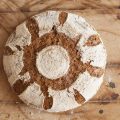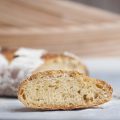Looking to add more flavor complexity to your bread baking? Sourdough rye offers a uniquely tasty and nutrient-dense alternative to regular loaves, with sour and sweet notes that make sandwiches a revelation. Diving into the world of sourdough rye bread, a treasure trove of rich flavors and hearty textures awaits. Uncover the secrets to mastering this rustic classic, ensuring each slice is a perfect balance of tangy and tender, a true delight for any baker.
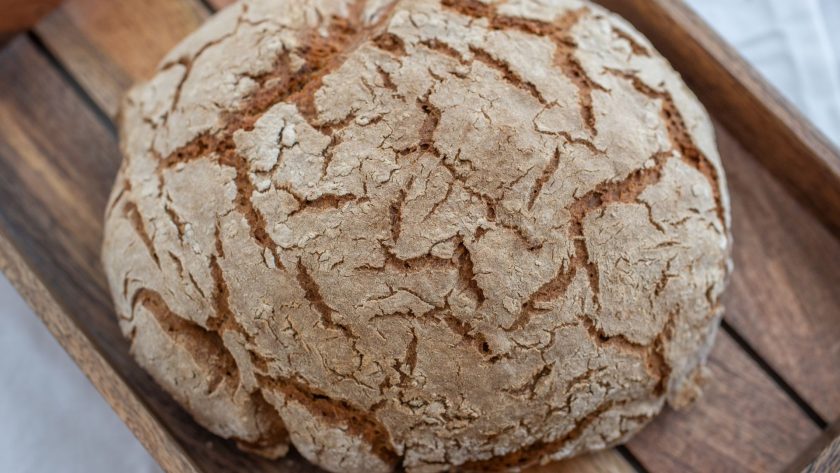
Table of Contents
- What is Sourdough Rye Bread?
- Sourdough Rye Bread vs. Traditional Sourdough
- Do You Need a Rye Flour Sourdough Starter?
- What to Know Before Using Rye for Sourdough
- How to Make Rye Starter for Sourdough
- How to Make Rye Sourdough Bread
- Tips for Best Rye Sourdough
- Sourdough Rye Bread Varieties
- Common Problems and Solutions with Rye Sourdough
- Sourdough Rye Bread Pairing Ideas
- How to Store Sourdough Rye
- Rye Not? A Culinary Adventure into Sourdough Rye Bread
- FAQs
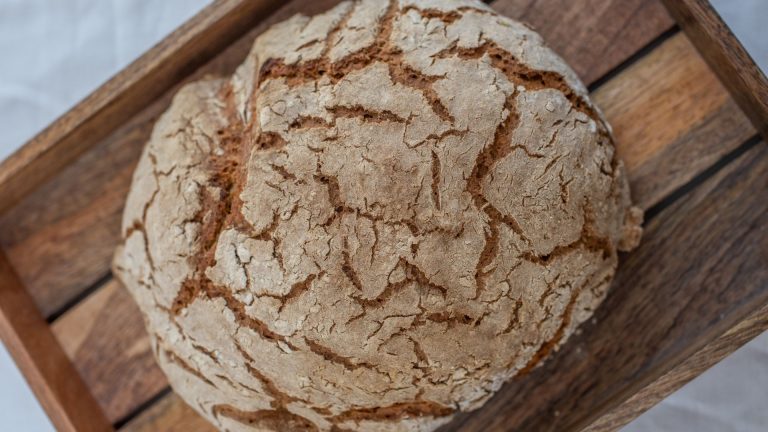
Sourdough Rye Bread Recipe
Enjoy your homemade rye sourdough bread! Experiment with fermentation times or flour ratios to make the bread your own!
- Total Time: 45 minutes
- Yield: 1 loaf (12 servings) 1x
Ingredients
- 200g rye flour
- 300g bread flour
- 350ml water (room temperature)
- 100g active sourdough starter
- 10g salt
Equipment
- Mixing bowl
- Dough scraper
- Banneton (or any sourdough proofing basket)
- Dutch oven or baking stone
- Parchment paper
- Razor blade or sharp knife
Instructions
- Take 100g of your active starter and mix with 100g water and 100g bread flour.
- Let it sit at room temperature to become bubbly and active (about 4-6 hours).
- In a large bowl, mix 350ml water with the rye and bread flour until no dry flour remains.
- Let this mixture sit for 30 minutes to an hour (autolyse).
- Add the levain and salt, and mix thoroughly until well incorporated.
- Perform stretch and folds every 30 minutes for the first 2 hours.
- Then let the dough rest for the remaining time.
- The dough should be puffy and should have increased in volume by the end of bulk fermentation.
- Gently turn the dough out onto a lightly floured surface.
- Pre-shape it into a round.
- Let it rest for 20 to 30 minutes.
- Shape the dough into a tight ball and place it into the proofing basket.
- Cover and let it proof overnight in the refrigerator.
- Preheat your oven to 250°C (480°F) with a Dutch oven or baking stone inside.
- Take the dough out of the refrigerator.
- Turn it onto a piece of parchment paper.
- Score the top with a razor blade or sharp knife.
- Place it in the Dutch oven or on the baking stone.
- Reduce oven temperature to 230°C (450°F).
- Bake for 20 minutes with the lid on (if using a Dutch oven).
- Remove the lid and bake for another 20-25 minutes until the crust is deeply caramelized.
- Remove the bread from the oven and let it cool on a wire rack for at least 1 hour before slicing.
Notes
- Use a rye-based starter if possible to better match dough flavors. And don’t forget to save a bit to continue propagating it!
- Weigh your ingredients precisely and use the “float test” – a small dough sample dropped in water that floats when properly hydrated.
- Use stretch and fold techniques rather than heavy kneading to strengthen gluten strands with minimal degassing. Shape loaves delicately as well before the final proofing.
-
An overnight cold proof in the refrigerator allows acid production to continue while firming up the shaped loaves. A long covered preheat with steam boosts oven spring for an open, irregular crumb.
- Cook Time: 45 mins
- Category: bread
Nutrition
- Serving Size: 1 slice
- Calories: 158 kcal
- Sodium: 362 mg
- Fat: 0.54 g
- Carbohydrates: 34 g
- Fiber: 3 g
- Protein: 4 g
What is Sourdough Rye Bread?
Sourdough rye bread brings together the nutty, earthy qualities of rye flour with the zesty tartness imparted by a sourdough starter.
Historical Origins
Rye has been used in breadmaking for centuries, especially across Eastern and Central Europe where the crop thrives in harsh climates. German pumpernickel bread is probably the most famous form of sourdough rye. However, Eastern European countries like Poland, Russia and the Baltic states have their own beloved takes on dense, tangy rye bread, which forms a dietary staple across the region. The slower fermentation characteristic of sourdough rye allows for better digestion of rye’s complex carbohydrates.
Basic Ingredients
Traditional sourdough rye bread contains just a few simple components:
- Rye flour – Usually a mix of dark rye and white rye flours. Dark rye has a more assertive flavor.
- Sourdough starter – Cultivated yeast and bacteria culture to leaven the bread.
- Water – Hydrates the dough to develop gluten.
- Salt – For flavor and to strengthen gluten bonds.
- Caraway seeds – An optional but popular addition that contributes a distinctive anise-like aroma.
The simplicity of ingredients allows the natural flavors of the rye and sourdough fermentation to take center stage.
Sourdough Rye Bread vs. Traditional Sourdough
Why would you make sourdough rye instead of regular sourdough? There’s actually a few advantages that rye has over regular wheat.
Traditional sourdough uses wheat flour, sourdough rye utilizes rye flour instead. This simple ingredient swap creates noticeably different textures, flavors, and preparation methods between the two breads.
Texture and Crumb
The most obvious difference is in the texture.
Traditional sourdough has an open crumb structure with large, irregular holes. Sourdough rye, on the other hand, achieves a dense, close-crumbed texture. This comes down to the lack of gluten in rye versus wheat. The result is a pleasantly chewy, almost meaty texture.
Flavor Profiles
Swapping the flour also impacts the flavor.
Wheat sourdough tends to have a predominantly sour taste from the long fermentation with notes of nuttiness. Rye sourdough delivers an earthier, more complex flavor. The rye grain contributes hints of caramel, coffee, and licorice-like sweetness to balance out the sourness. This makes it more boldly flavored than wheat-based counterparts.
Preparation Differences
The preparation method also varies slightly between the two:
- Starter – A rye starter is often used to better match the flour. This promotes faster rising.
- Mix-ins – Caraway seeds, coriander, fennel and other spices are added to complement the rye’s strong flavor.
- Extended Fermentation – The complex carbs in rye flour require longer fermentation by the starter cultures to break down and properly rise. This develops the beloved flavor.
Enhanced Fermentation Flavors
Another signature quality of rye flour is intensifying taste through longer fermentation. The starch and fiber in rye flour is more complex than wheat. It takes longer chains of microbial activity to break down the starches into sugars, acids and carbon dioxide for leavening and rising. But this extended ferment unlocks more complex, aromatic flavors. Nutty, earthy, slightly chocolatey notes come forward to balance the bright sourness.
Better Nutrition and Digestibility
The same properties that lead to dense texture and bold taste also offer nutritional benefits. The longer ferment helps break down difficult-to-digest compounds in rye. This may promote better nutrient absorption for some. The fiber and minerals in rye also make it a more nutritionally complete grain. The compact crumb becomes almost cake-like for pleasant eating.
For these reasons, rye sourdough has traditionally been viewed as a very wholesome, nourishing bread.
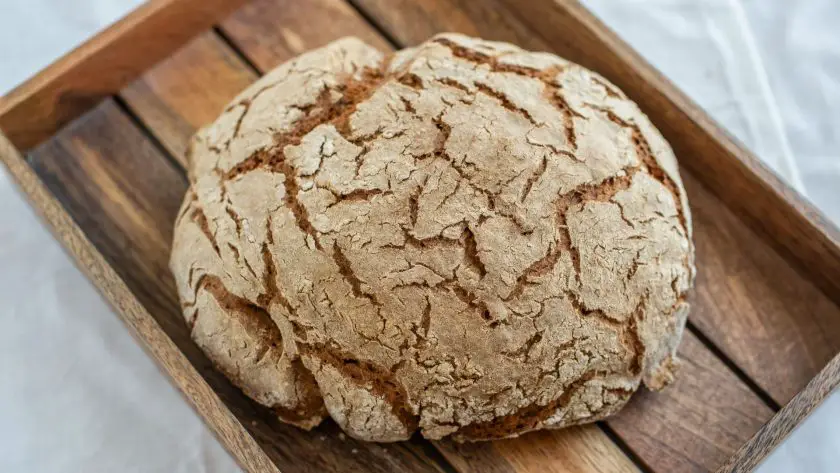
Do You Need a Rye Flour Sourdough Starter?
A rye-based starter can offer advantages over a regular wheat starter. Rye starters better match the dough ingredients and speed up fermentation. However, a wheat starter can still work perfectly fine.
Why Use a Rye Starter
The main reason to use an all-rye or rye-wheat starter is to align the starter with the flavor and properties of the bread dough. Rye starters tend to be more active with a faster rise time. This gives a jumpstart to leavening the dough. The flavors also match well, promoting fermentation complexity.
Using a Wheat Starter
With that said, a wheat-based starter can still effectively leaven rye doughs. It just may take longer for the rise depending on activity level. Slow fermentation is even desirable for flavor in a rye loaf. The wheat notes will come through but not necessarily clash with nutty rye flavors.
Don’t shy away from using an existing wheat starter if that’s all you have on hand. Adjusting other variables like fermentation time can still result in great homemade sourdough rye.
What to Know Before Using Rye for Sourdough
Rye requires some adjustments from typical bread recipes. Keep these in mind before attempting your first rye sourdough loaf. Understanding the quirks of rye will lead to delicious results.
Types of Rye Flour
Not all rye flours act the same, so the variety you use will impact the dough.
Dark or pumpernickel rye imparts the most assertive flavor and darkest color. Light or white rye has milder taste and color. Most recipes combine the two for balanced depth and rise. Whole grain rye contains the germ and bran for nutritional benefits but won’t rise as much. Know your ingredients.
Hydration Levels
The starting dough hydration generally needs to be wetter with rye, in the 85-95% range. Rye doesn’t form gluten easily to develop structure. The extra moisture compensates and allows flexibility to properly mix, knead and proof the loaves. Lower hydration can yield loaves that are too dry and dense.
Long, Slow Fermentation
Starches and proteins in rye require longer breakdown by starter cultures. Build in 8-12 hours of cool fermentation time for flavor developing proteolysis and proper rise. This extended timeframe unlocks the full potential of rye in sourdough. Have patience.
Measure Precisely
Because rye fermentation can be finicky, accuracy in ingredients is key. Carefully weigh out flour and water amounts. Monitor dough temperature. And use an active, peaked starter fed within the past 8-12 hours.
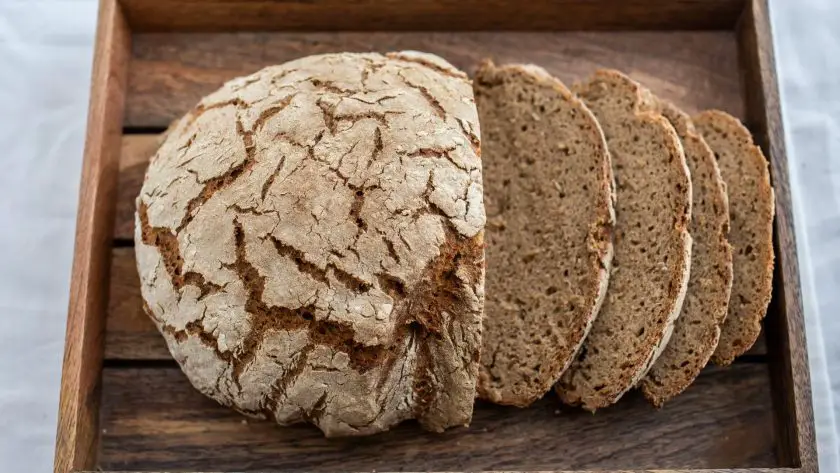
How to Make Rye Starter for Sourdough
Ingredients
- Rye flour (whole grain is preferred for its nutrient content)
- Water (filtered or dechlorinated water is best)
Equipment
- A clean jar (sourdough starter jars should be preferably glass, about 500ml to 1L capacity)
- A kitchen scale
- A spoon for stirring
- A cloth or paper towel and a rubber band or jar ring
Starter Schedule
Day 1
- Mixing: In your jar, combine 50g of rye flour with 50g of water. Stir thoroughly to ensure there are no dry patches of flour.
- Covering: Cover the jar with a cloth or paper towel and secure it with a rubber band. This allows air to circulate while keeping out dust and insects.
- Storing: Place the jar in a spot at room temperature, away from direct sunlight.
Day 2 to Day 5 (or 7)
- Feeding (Twice Daily): Twice a day (morning and evening), discard about half of your starter (around 50g), and add 50g of rye flour and 50g of water. Stir well.
- Observation: Look for signs of activity, such as bubbles and a slightly sour smell. The mixture will become more lively and will start to rise in the jar.
Day 6 (or when the starter is reliably doubling in size between feedings)
- Regular Feedings: Now, your starter should be active and ready for regular use. Continue feeding it daily if kept at room temperature, or weekly if stored in the refrigerator.
- Refrigeration (Optional): If you don’t plan to use your starter daily, you can store it in the refrigerator and feed it once a week. Let it come to room temperature before using it for baking.
Notes
- Consistency: The starter should have a thick but stirrable consistency, like a thick pancake batter.
- Temperature: Warmer temperatures can accelerate fermentation, while cooler temperatures slow it down.
- Water: If your tap water is heavily chlorinated, consider using filtered or bottled water.
- Flour: While this recipe uses rye flour, you can transition to using other types of flour for the feedings once your starter is established.
- Usage: When your starter is rising and falling predictably and has a pleasant sour smell, it’s ready to use for baking.
Remember, creating a sourdough starter is a bit of an adventure and can vary based on your environment. If your starter isn’t showing much activity after several days, try moving it to a warmer spot or adjusting the flour/water ratio slightly.
How to Make Rye Sourdough Bread
This recipe assumes you already have a mature active sourdough starter. If you don’t, you’ll need to prepare one a few days in advance – refer to the recipe above!
And now let’s get to making sourdough rye bread!
Ingredients
- 200g rye flour
- 300g bread flour
- 350ml water (room temperature)
- 100g active sourdough starter
- 10g salt
Equipment
- Mixing bowl
- Dough scraper
- Banneton (or any sourdough proofing basket)
- Dutch oven or baking stone
- Parchment paper
- Razor blade or sharp knife
Baking Schedule
Day 1
- Morning (9:00 AM): Levain Build
- Take 100g of your active starter and mix with 100g water and 100g bread flour.
- Let it sit at room temperature to become bubbly and active (about 4-6 hours).
- Afternoon (3:00 PM): Autolyse and Mix
- In a large bowl, mix 350ml water with the rye and bread flour until no dry flour remains.
- Let this mixture sit for 30 minutes to an hour (autolyse).
- Add the levain and salt, and mix thoroughly until well incorporated.
- Afternoon (4:00 PM to 8:00 PM): Bulk Fermentation
- Perform stretch and folds every 30 minutes for the first 2 hours.
- Then let the dough rest for the remaining time.
- The dough should be puffy and should have increased in volume by the end of bulk fermentation.
- Evening (8:00 PM): Pre-shape
- Gently turn the dough out onto a lightly floured surface.
- Pre-shape it into a round.
- Let it rest for 20 to 30 minutes.
- Evening (8:30 PM): Final Shape and Proof
- Shape the dough into a tight ball and place it into the proofing basket.
- Cover and let it proof overnight in the refrigerator.
Day 2
- Morning (9:00 AM): Preheat Oven
- Preheat your oven to 250°C (480°F) with a Dutch oven or baking stone inside.
- Morning (9:30 AM): Score and Bake
- Take the dough out of the refrigerator.
- Turn it onto a piece of parchment paper.
- Score the top with a razor blade or sharp knife.
- Place it in the Dutch oven or on the baking stone.
- Reduce oven temperature to 230°C (450°F).
- Bake for 20 minutes with the lid on (if using a Dutch oven).
- Remove the lid and bake for another 20-25 minutes until the crust is deeply caramelized.
- Morning (10:15 AM): Cooling
- Remove the bread from the oven and let it cool on a wire rack for at least 1 hour before slicing.
Enjoy your homemade rye sourdough bread! Experiment with fermentation times or flour ratios to make the bread your own!
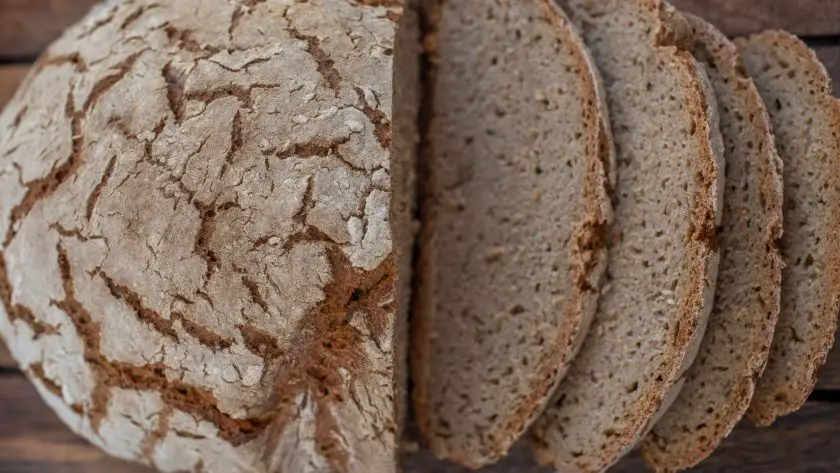
Tips for Best Rye Sourdough
Don’t get discouraged if initial loaves are too dense or flat – diagnose what step may need tweaking and keep experimenting!
Start with a Strong Starter
The foundation for exceptional sourdough is an active, mature starter 6-8 hours from its last feeding. This ensures yeasts and bacteria are at full fermentation strength when added.
Use a rye-based starter if possible to better match dough flavors. And don’t forget to save a bit to continue propagating it!
Optimize Hydration
Getting sufficient moisture into a rye dough boosts rise and results in a moist, chewy crumb when baked. Most recipes call for 85-95% hydration. Weigh your ingredients precisely and use the “float test” – a small dough sample dropped in water that floats when properly hydrated. The dough will seem almost too sticky wet at first but resist the urge to add more flour.
Gentle Handling
Rye dough must be handled more gingerly to preserve gas bubbles that provide lift. Use stretch and fold techniques rather than heavy kneading to strengthen gluten strands with minimal degassing. Shape loaves delicately as well before the final proofing.
Embrace Acidity
The lactic and acetic acids are what give sourdough its tangy zip and help break down complex rye compounds. An overnight cold proof in the refrigerator allows acid production to continue while firming up the shaped loaves. A long covered preheat with steam boosts oven spring for an open, irregular crumb.
Sourdough Rye Bread Varieties
Altering the flavor of rye sourdough bread can be a delightful exploration. Each change can affect not only the flavor but also the texture and appearance of the bread. It’s often a good idea to make one change at a time so you can clearly see its impact.
- Adjust the Flour Blend: Mix rye flour with different types of flour like whole wheat, spelt, or white bread flour. Each flour contributes its own unique flavor profile and texture to the bread.
- Incorporate Additional Grains: Add grains like oats, barley, or millet to the dough. Soaking these grains beforehand can enhance their flavor and texture in the finished bread.
- Experiment with Hydration Levels: Changing the water content in your dough can affect the sourdough’s flavor and crumb structure. Higher hydration often leads to a more open crumb and a subtly different flavor.
- Utilize Different Types of Rye: There are various types of rye flour, such as white rye, dark rye flour, and pumpernickel. Each type brings a different depth of flavor and color to your sourdough.
- Flavor Add-Ins: Incorporate ingredients like seeds (caraway, sunflower, flaxseed), nuts, dried fruits, herbs (rosemary, thyme), or spices (cumin, fennel) into your dough to introduce new flavors.
- Change the Fermentation Time: Altering the length of fermentation can impact the sourness of the bread. A longer fermentation generally increases the sour flavor, while a shorter one results in a milder taste.
- Try Different Starters: The type of sourdough starter can affect the flavor. A rye flour starter will impart a different taste compared to a wheat flour starter. You can also experiment with starters that have been fermented for different lengths of time.
- Use Sweeteners: Introduce sweeteners like honey, molasses, or brown sugar to add a hint of sweetness and depth to the flavor profile.
- Addition of Dairy or Fat: Ingredients like butter, olive oil, or buttermilk can enrich the dough, contributing to a softer texture and a nuanced flavor. I have two recipes that adds milk (my Sourdough Rye Bread with Milk Kefir) and yogurt (in this Rye Sourdough with Homemade Yogurt).
- Incorporate Pre-ferments: Use techniques like a poolish or biga pre-ferment, which can offer more complex flavors to the sourdough bread.
- Play with Salt Varieties: Experiment with different types of salt, like sea salt, Himalayan pink salt, or flavored salts, which can subtly alter the flavor.
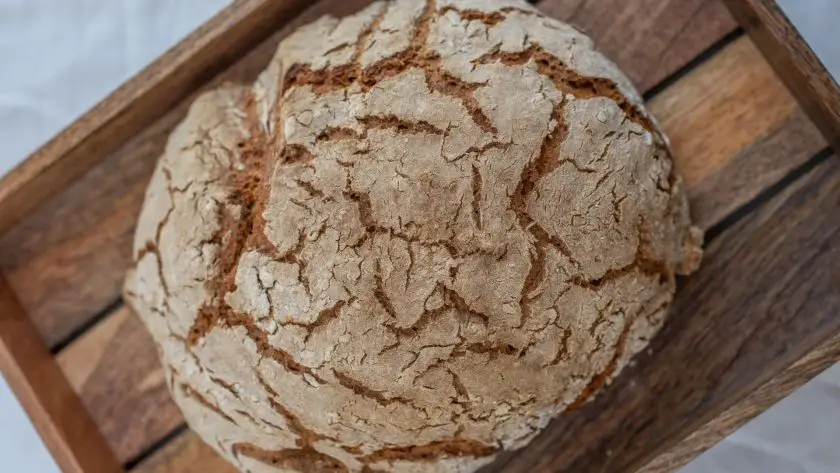
Common Problems and Solutions with Rye Sourdough
Rye sourdough brings its own challenges thanks to finicky rye flour. But most issues that arise can be addressed with a few simple tweaks. Making adjustments to ingredients, process and handling will help troubleshoot most rye sourdough issues for better homemade loaves!
Dense, Gummy Crumb
- The Problem – Rather than light and airy, your rye loaf turns out as a heavy brick with a gluey texture.
- The Solution – Check your hydration level and process. Rye needs extra water – 85%+ hydration – to properly swell starches and develop structure. Make sure to weigh ingredients rather than eyeball them. And use stretch and folds over aggressive kneading to handle sticky high hydration doughs.
Won’t Rise Properly
- The Problem – Your shaped loaves rise slowly or unevenly before baking. Or they don’t expand much in the oven.
- The Solution – Rye fermentation requires patience thanks to complex carbs. Allow your starter levain, bulk ferment and proofing plenty of time – 8+ hours total. Watch dough temperature as well. Ensure your starter is bubbly and active. And handle the dough gently to avoid deflating.
Lackluster Flavor
- The Problem – You were expecting big rye flavor but the bread turns out mild or one-note sour.
- The Solution – Lengthen the fermentation. That extended microbial breakdown is key for developing tangy, complex taste. Adjust your starter hydration so it peaks vigorously. And ensure your dough doesn’t rise too warm – below 80F is ideal. Cooler = more flavor.
Sourdough Rye Bread Pairing Ideas
Rye’s adaptability lets you explore all sorts of flavor combinations beyond traditional deli meats. The complex nutty, tangy flavor of sourdough rye bread makes it highly versatile to pair with both savory and sweet additions.
Hearty Proteins
Lean meats like roast beef, turkey, chicken or pork tenderloin make excellent sandwiches on rye bread. The dense, chewy crumb stands up well to thin sliced proteins. Pastrami, corned beef or European cheeses like Swiss also marry beautifully. For breakfast, smoked salmon or lox with onions, tomatoes and cream cheese is a classic combination.
Roasted Vegetables
The earthiness of sourdough rye complements rich roasted vegetables like mushrooms, eggplant, carrots and beets. Try a toasted rye bread bowl for serving up flavorful veggie ragouts or medialunas topped with roasted peppers. Grilled vegetables and caramelized onions also sing between rye bread slices.
Pickled Flavors
As a Baltic region staple, rye bread loves piquant pickled flavors. A few thin slices of rye bread served with pickles, pickled vegetables and cured meats makes an easy app. Or slather the bread with mustard and sauerkraut for sandwiches and open-faced tartines. Quick refrigerator pickles elevate rye bread into an exciting bite.
Sweets Contrast
While less expected, tart rye serves as an intriguing foil to sweet jams, nut butters and chocolate spreads. Toast thick slices for breakfast and top with homemade jam. Spread ginger molasses or orange marmalade between layers of thin rye sourdough bread for a unique cake. Allow the tanginess of rye to cut sweetness for balanced enjoyment.
How to Store Sourdough Rye
Sourdough rye bread is best enjoyed fresh. But storing properly can maintain tasty loaves for days after baking.
Countertop
For next-day sandwiches, wrap cooled bread in a clean kitchen towel or baguette sack. The natural moisture retention of rye keeps the interior soft but the exterior crisp for up to 3 days. Avoid paper or plastic bags that trap moisture and accelerate staling.
- Size Information: our linen bread bags are manufactured in 2 sizes, about 10 x 12 inches and 6 x 26 inches in length and width, which are appropriate dimensions to fit various areas in your home, and they wont occupy much space on your countertop or dining table
- Reusable and Washable: these reusable bread bags are made of quality linen material, lightweight and sturdy, washable and reusable, and will not tear or fade easily, which can be applied for a long time; They stay firm after washing, and what you need to do is completely dry and iron them to get them back to their original shape
- Practical Drawstrings: our baguette bags are designed with drawstrings, which enable you to safely protect your bread from the infringement of dust and dirt, keep your bread fresh for a longer time, and make it comfortable for you to carry around when you are on a trip
- Wide Applications: our reusable bread bags for homemade bread can be widely applied to store pieces of bread, French shortbread, pastry, potatoes, vegetables, grains, and so forth on various occasions such as in your home kitchen, bakeries, restaurants, and so
Prices pulled from the Amazon Product Advertising API on:
Product prices and availability are accurate as of the date/time indicated and are subject to change. Any price and availability information displayed on [relevant Amazon Site(s), as applicable] at the time of purchase will apply to the purchase of this product.
Breadbox
For maximum crunch, store sliced rye bread in a breadbox or basket on the countertop. The ventilation circulates air to prevent moisture buildup. Spin the loaf daily and consume within 5 days for premium freshness.
- 【𝐒𝐚𝐯𝐞 𝐒𝐩𝐚𝐜𝐞 𝐎𝐧 𝐘𝐨𝐮𝐫 𝐊𝐢𝐭𝐜𝐡𝐞𝐧 𝐂𝐨𝐮𝐧𝐭𝐞𝐫】:With an ergonomic right-angle design, this corner bread box fits easily any spare corner on your kitchen countertop and leaves you with extra space for your cooking activities and the top of the bread box is available for you to put more kitchen stuffs on it.
- 【𝐊𝐄𝐄𝐏𝐒 𝐁𝐑𝐄𝐀𝐃 𝐅𝐑𝐄𝐒𝐇】: Unlike airtight containers that quickly dry out and stale the bread, our bread saver box retains just enough moisture to keep most bread fresh for up to 3 or 4 full days and prevent your bread inside from any unnecessary air.
- 【𝐋𝐚𝐫𝐠𝐞 𝐂𝐚𝐩𝐚𝐜𝐢𝐭𝐲 𝐚𝐧𝐝 𝐀𝐝𝐣𝐮𝐬𝐭𝐚𝐛𝐥𝐞 𝐇𝐞𝐢𝐠𝐡𝐭】: Our 2 layers board is large enough to hold 2 large loaves of bread, rolls, muffins and more, which will avoid effectively deformation of bread caused by extrusion.The partition in the middle of our bread box is designed with three adjustable heights to store bread and kitchen supplies of any size.
- 【𝐒𝐭𝐮𝐫𝐝𝐲, 𝐒𝐭𝐲𝐥𝐢𝐬𝐡, 𝐄𝐚𝐬𝐲 𝐀𝐬𝐬𝐞𝐦𝐛𝐥𝐲】: It’s an ideal choice to store and display your bread and baked goods inside this kitchen countertop bread keeper that are made of strong bamboo wood; its farmhouse chic style will add to your home’s rustic decor. Screwdriver is included in the package for easy assembly.
- 【𝐀𝐝𝐝 𝐍𝐚𝐭𝐮𝐫𝐚𝐥 𝐒𝐭𝐲𝐥𝐞 𝐓𝐨 𝐘𝐨𝐮𝐫 𝐊𝐢𝐭𝐜𝐡𝐞𝐧】: This sleek bamboo bread box blends with any type of kitchen decoration and the material is made of 100% natural bamboo. Premium and practical farmhouse kitchen storage box, perfect for your kitchen as well as your dining ro
Prices pulled from the Amazon Product Advertising API on:
Product prices and availability are accurate as of the date/time indicated and are subject to change. Any price and availability information displayed on [relevant Amazon Site(s), as applicable] at the time of purchase will apply to the purchase of this product.
Freezer
Freezing extends shelf life significantly. Allow bread to cool completely after baking then wrap tightly in plastic wrap followed by freezer bag. Squeeze out excess air. Thaw at room temperature in the packaging then refresh for 5 minutes at 375°F. The crumb will revive slightly.
Fridge
Refrigeration also works for short term storage to pause staling. Let bread cool completely first then wrap in paper or bag. Condensation can make the crust soggy so refresh in a 400°F oven to recrisp. Consume fridge-stored rye bread within a week.
Rye Not? A Culinary Adventure into Sourdough Rye Bread
For those longing for a satisfying sliced bread with personality, look no further than sourdough bread using rye bread flour. While finicky to work with, a few simple tricks can yield superior loaves.
A little patience in the kitchen delivers great taste in every bite.
FAQs
Is Rye Sourdough Bread Healthy?
With its nutty flavor and chewy texture, rye sourdough makes a satisfying and potentially healthier alternative to regular wheat breads. While no bread alone makes a healthy diet, nutrient-packed sourdough rye can be part of a balanced regimen for improved digestion, blood sugar regulation and satiety. Moderation and smart pairing makes rye a potential boon.
What Does Sourdough Rye Taste Like?
Sourdough rye bread has a complex, tangy flavor with notes of tart citrus, earthy rye, sweet caramel, savory yeast, and pleasant bitter tannins, making it a uniquely tasty multidimensional eating experience perfect for sandwiches, rolls, or enjoying by itself.
What Is the Difference Between Sourdough and Rye Sourdough?
Sourdough rye uses rye flour instead of wheat, developing a meatier chewy texture, bolder earthy taste balanced by sweet and sour notes, and better nutrition and digestibility from the longer fermentation required to break down rye’s complex carbs.
Is Rye Flour Better for Sourdough?
Yes, rye flour is better for sourdough thanks to its hearty flavor and nutritional benefits. The complex carbs require extended fermentation which develops a tangy, sweet-sour taste. The resulting bread also has a nice dense texture and easier digestibility.
Does Rye Flour Make Sourdough More Sour?
Rye flour can make sourdough bread taste more sour due to its chemistry. It ferments faster and more efficiently than wheat, creating a favorable environment for acid-producing bacteria. This results in a more pronounced sour flavor in the sourdough bread.




